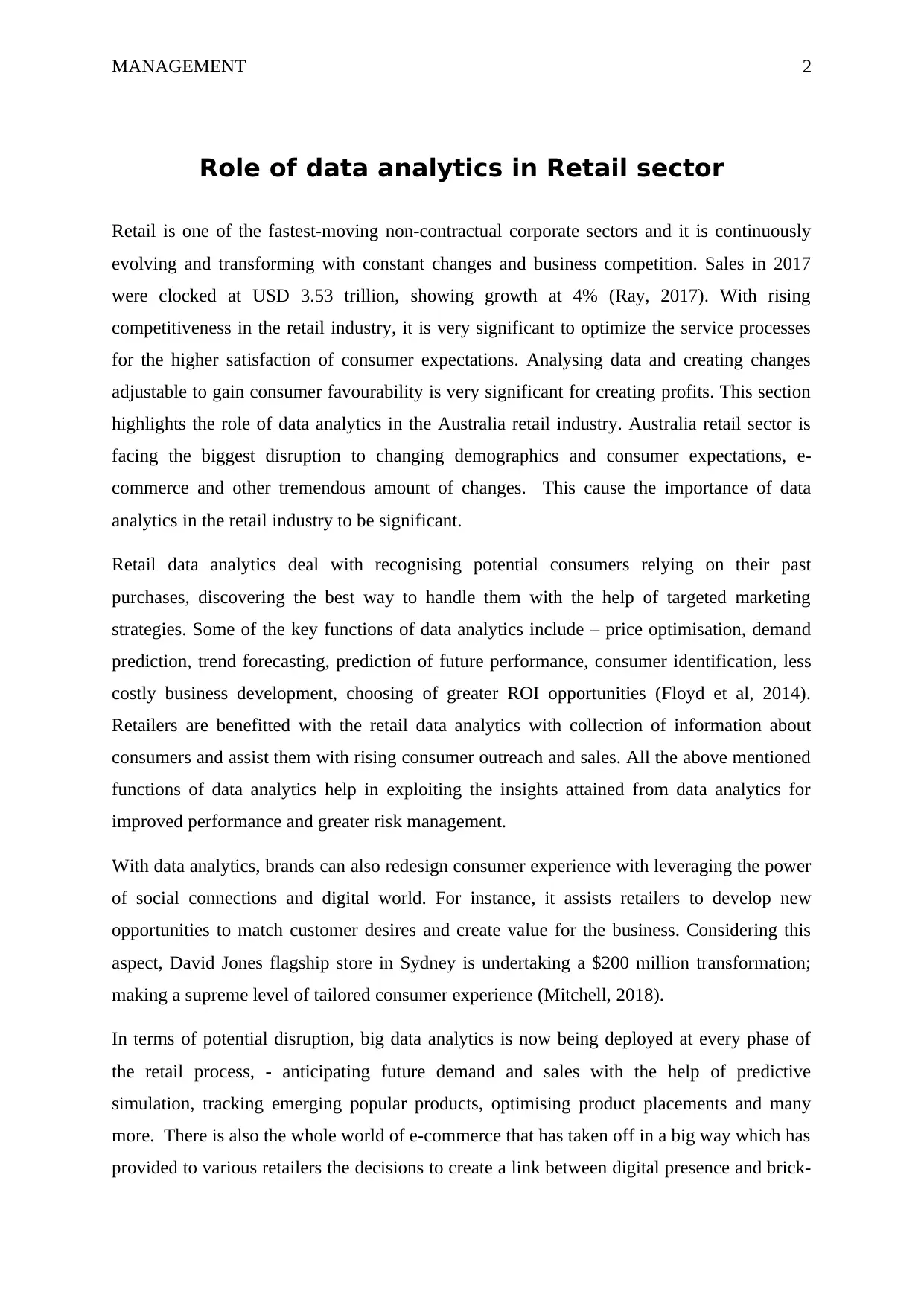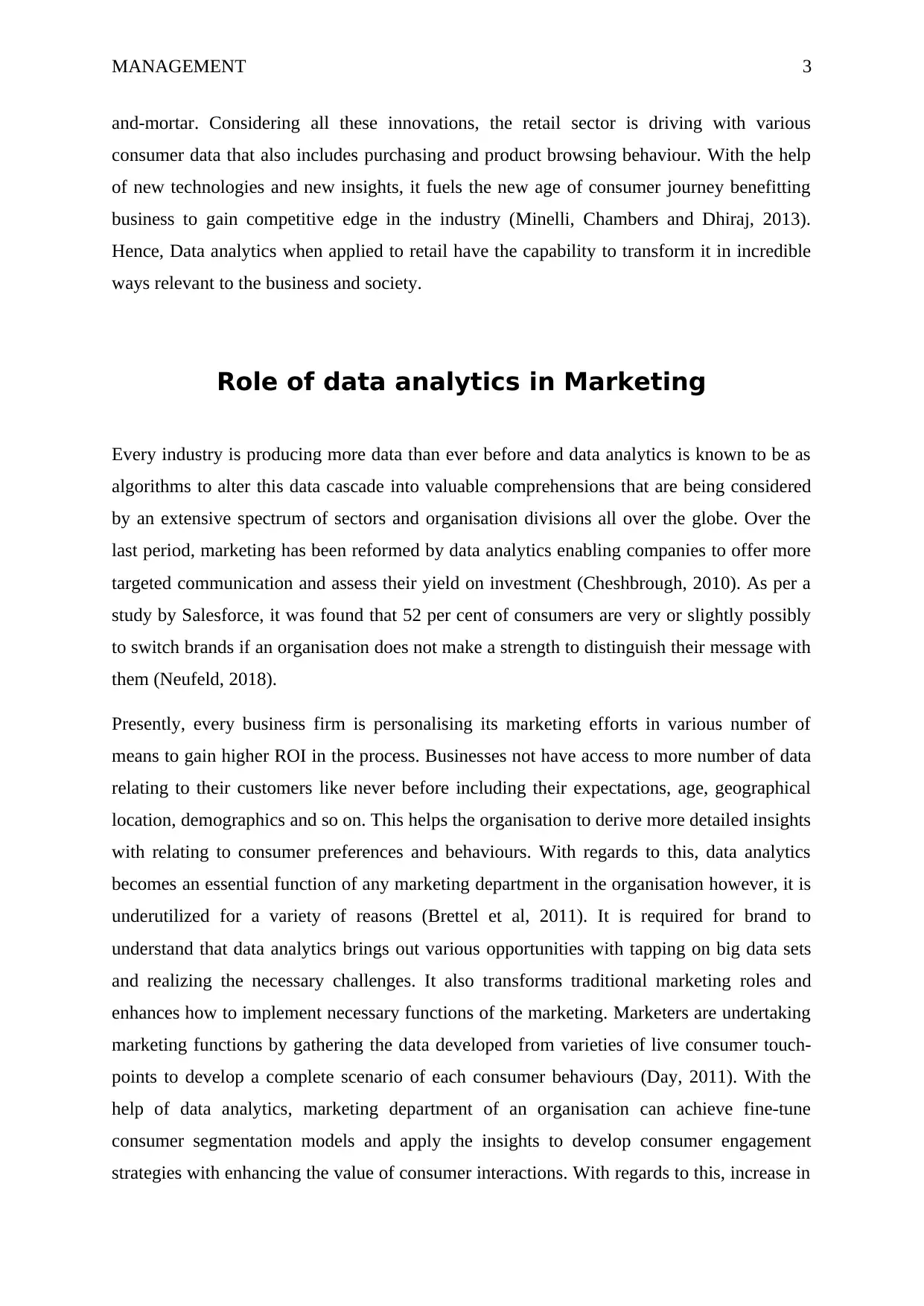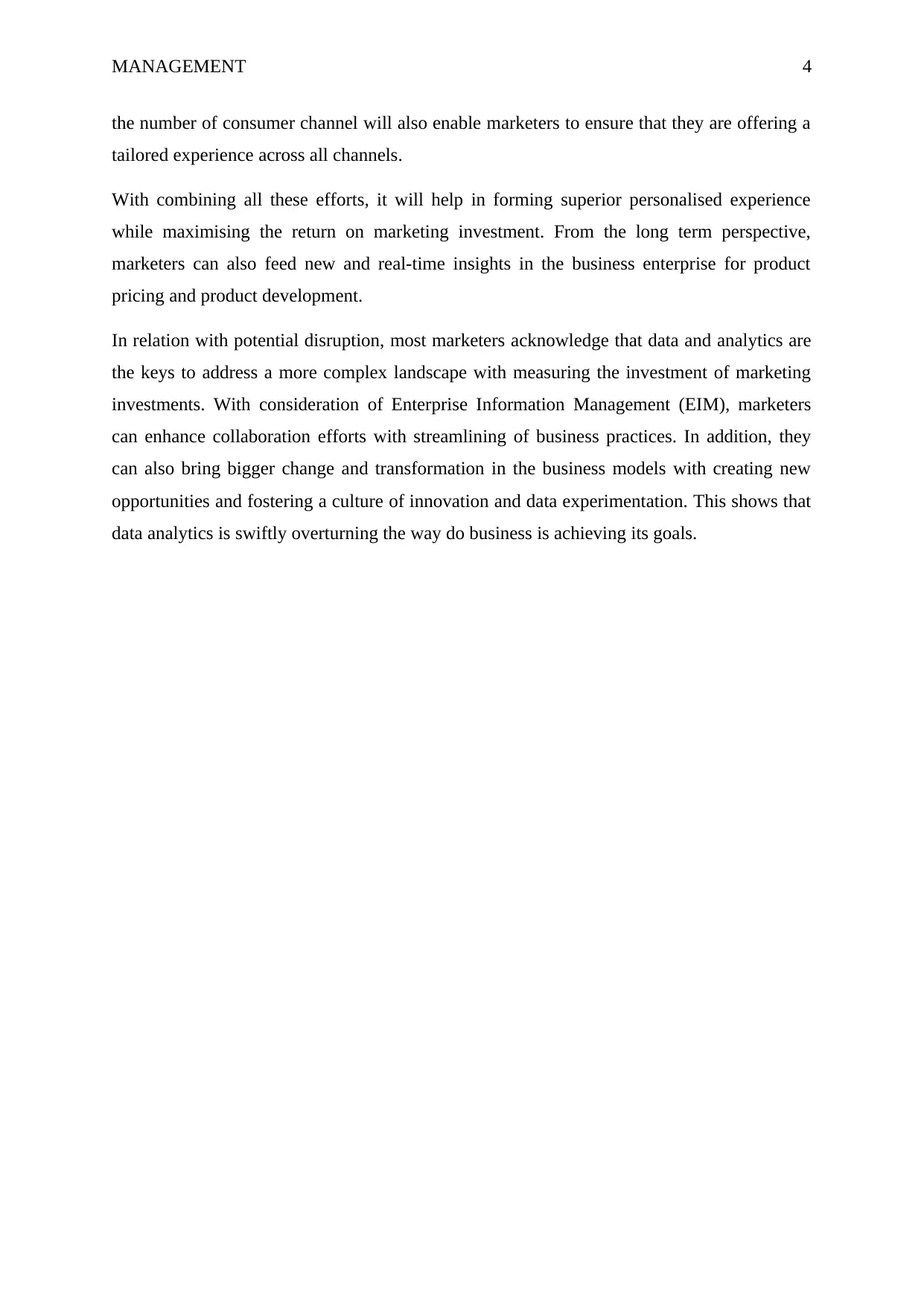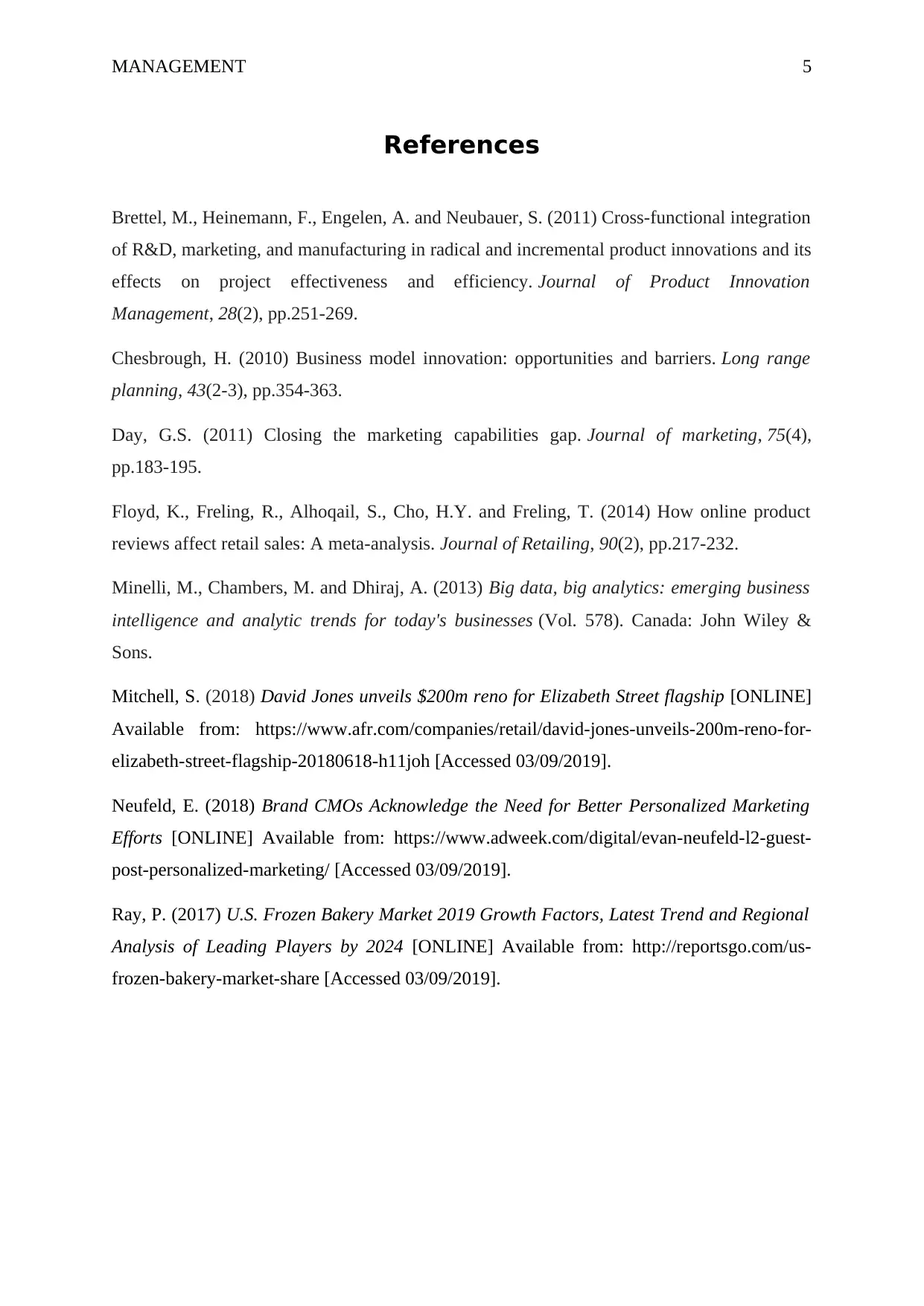Disruption in Business: Data Analytics Role and Impact Report
VerifiedAdded on 2022/11/13
|6
|1347
|264
Report
AI Summary
This report examines the critical role of data analytics in driving disruption across the retail and marketing sectors. The report begins by analyzing the impact of data analytics in the retail industry, emphasizing its use in optimizing service processes, understanding consumer behavior, and forecasting trends. It discusses how data analytics aids in price optimization, demand prediction, and consumer identification, ultimately helping retailers improve performance and manage risks. The report then shifts to marketing, highlighting how data analytics enables personalized communication and improves return on investment. It emphasizes the use of data to understand consumer preferences, segment markets, and create tailored customer experiences across multiple channels. The report underscores the potential for disruption in both sectors, emphasizing how businesses are leveraging data analytics to gain a competitive edge, adapt to changing consumer expectations, and drive innovation. The report references key functions of data analytics including demand prediction, trend forecasting, consumer identification, and improved ROI opportunities.

Running Head: MANAGEMENT 0
Disruption in Business
Disruption in Business
Paraphrase This Document
Need a fresh take? Get an instant paraphrase of this document with our AI Paraphraser

MANAGEMENT 1
Table of Contents
Role of data analytics in Retail sector....................................................................................2
Role of data analytics in Marketing.......................................................................................3
References.................................................................................................................................5
Table of Contents
Role of data analytics in Retail sector....................................................................................2
Role of data analytics in Marketing.......................................................................................3
References.................................................................................................................................5

MANAGEMENT 2
Role of data analytics in Retail sector
Retail is one of the fastest-moving non-contractual corporate sectors and it is continuously
evolving and transforming with constant changes and business competition. Sales in 2017
were clocked at USD 3.53 trillion, showing growth at 4% (Ray, 2017). With rising
competitiveness in the retail industry, it is very significant to optimize the service processes
for the higher satisfaction of consumer expectations. Analysing data and creating changes
adjustable to gain consumer favourability is very significant for creating profits. This section
highlights the role of data analytics in the Australia retail industry. Australia retail sector is
facing the biggest disruption to changing demographics and consumer expectations, e-
commerce and other tremendous amount of changes. This cause the importance of data
analytics in the retail industry to be significant.
Retail data analytics deal with recognising potential consumers relying on their past
purchases, discovering the best way to handle them with the help of targeted marketing
strategies. Some of the key functions of data analytics include – price optimisation, demand
prediction, trend forecasting, prediction of future performance, consumer identification, less
costly business development, choosing of greater ROI opportunities (Floyd et al, 2014).
Retailers are benefitted with the retail data analytics with collection of information about
consumers and assist them with rising consumer outreach and sales. All the above mentioned
functions of data analytics help in exploiting the insights attained from data analytics for
improved performance and greater risk management.
With data analytics, brands can also redesign consumer experience with leveraging the power
of social connections and digital world. For instance, it assists retailers to develop new
opportunities to match customer desires and create value for the business. Considering this
aspect, David Jones flagship store in Sydney is undertaking a $200 million transformation;
making a supreme level of tailored consumer experience (Mitchell, 2018).
In terms of potential disruption, big data analytics is now being deployed at every phase of
the retail process, - anticipating future demand and sales with the help of predictive
simulation, tracking emerging popular products, optimising product placements and many
more. There is also the whole world of e-commerce that has taken off in a big way which has
provided to various retailers the decisions to create a link between digital presence and brick-
Role of data analytics in Retail sector
Retail is one of the fastest-moving non-contractual corporate sectors and it is continuously
evolving and transforming with constant changes and business competition. Sales in 2017
were clocked at USD 3.53 trillion, showing growth at 4% (Ray, 2017). With rising
competitiveness in the retail industry, it is very significant to optimize the service processes
for the higher satisfaction of consumer expectations. Analysing data and creating changes
adjustable to gain consumer favourability is very significant for creating profits. This section
highlights the role of data analytics in the Australia retail industry. Australia retail sector is
facing the biggest disruption to changing demographics and consumer expectations, e-
commerce and other tremendous amount of changes. This cause the importance of data
analytics in the retail industry to be significant.
Retail data analytics deal with recognising potential consumers relying on their past
purchases, discovering the best way to handle them with the help of targeted marketing
strategies. Some of the key functions of data analytics include – price optimisation, demand
prediction, trend forecasting, prediction of future performance, consumer identification, less
costly business development, choosing of greater ROI opportunities (Floyd et al, 2014).
Retailers are benefitted with the retail data analytics with collection of information about
consumers and assist them with rising consumer outreach and sales. All the above mentioned
functions of data analytics help in exploiting the insights attained from data analytics for
improved performance and greater risk management.
With data analytics, brands can also redesign consumer experience with leveraging the power
of social connections and digital world. For instance, it assists retailers to develop new
opportunities to match customer desires and create value for the business. Considering this
aspect, David Jones flagship store in Sydney is undertaking a $200 million transformation;
making a supreme level of tailored consumer experience (Mitchell, 2018).
In terms of potential disruption, big data analytics is now being deployed at every phase of
the retail process, - anticipating future demand and sales with the help of predictive
simulation, tracking emerging popular products, optimising product placements and many
more. There is also the whole world of e-commerce that has taken off in a big way which has
provided to various retailers the decisions to create a link between digital presence and brick-
⊘ This is a preview!⊘
Do you want full access?
Subscribe today to unlock all pages.

Trusted by 1+ million students worldwide

MANAGEMENT 3
and-mortar. Considering all these innovations, the retail sector is driving with various
consumer data that also includes purchasing and product browsing behaviour. With the help
of new technologies and new insights, it fuels the new age of consumer journey benefitting
business to gain competitive edge in the industry (Minelli, Chambers and Dhiraj, 2013).
Hence, Data analytics when applied to retail have the capability to transform it in incredible
ways relevant to the business and society.
Role of data analytics in Marketing
Every industry is producing more data than ever before and data analytics is known to be as
algorithms to alter this data cascade into valuable comprehensions that are being considered
by an extensive spectrum of sectors and organisation divisions all over the globe. Over the
last period, marketing has been reformed by data analytics enabling companies to offer more
targeted communication and assess their yield on investment (Cheshbrough, 2010). As per a
study by Salesforce, it was found that 52 per cent of consumers are very or slightly possibly
to switch brands if an organisation does not make a strength to distinguish their message with
them (Neufeld, 2018).
Presently, every business firm is personalising its marketing efforts in various number of
means to gain higher ROI in the process. Businesses not have access to more number of data
relating to their customers like never before including their expectations, age, geographical
location, demographics and so on. This helps the organisation to derive more detailed insights
with relating to consumer preferences and behaviours. With regards to this, data analytics
becomes an essential function of any marketing department in the organisation however, it is
underutilized for a variety of reasons (Brettel et al, 2011). It is required for brand to
understand that data analytics brings out various opportunities with tapping on big data sets
and realizing the necessary challenges. It also transforms traditional marketing roles and
enhances how to implement necessary functions of the marketing. Marketers are undertaking
marketing functions by gathering the data developed from varieties of live consumer touch-
points to develop a complete scenario of each consumer behaviours (Day, 2011). With the
help of data analytics, marketing department of an organisation can achieve fine-tune
consumer segmentation models and apply the insights to develop consumer engagement
strategies with enhancing the value of consumer interactions. With regards to this, increase in
and-mortar. Considering all these innovations, the retail sector is driving with various
consumer data that also includes purchasing and product browsing behaviour. With the help
of new technologies and new insights, it fuels the new age of consumer journey benefitting
business to gain competitive edge in the industry (Minelli, Chambers and Dhiraj, 2013).
Hence, Data analytics when applied to retail have the capability to transform it in incredible
ways relevant to the business and society.
Role of data analytics in Marketing
Every industry is producing more data than ever before and data analytics is known to be as
algorithms to alter this data cascade into valuable comprehensions that are being considered
by an extensive spectrum of sectors and organisation divisions all over the globe. Over the
last period, marketing has been reformed by data analytics enabling companies to offer more
targeted communication and assess their yield on investment (Cheshbrough, 2010). As per a
study by Salesforce, it was found that 52 per cent of consumers are very or slightly possibly
to switch brands if an organisation does not make a strength to distinguish their message with
them (Neufeld, 2018).
Presently, every business firm is personalising its marketing efforts in various number of
means to gain higher ROI in the process. Businesses not have access to more number of data
relating to their customers like never before including their expectations, age, geographical
location, demographics and so on. This helps the organisation to derive more detailed insights
with relating to consumer preferences and behaviours. With regards to this, data analytics
becomes an essential function of any marketing department in the organisation however, it is
underutilized for a variety of reasons (Brettel et al, 2011). It is required for brand to
understand that data analytics brings out various opportunities with tapping on big data sets
and realizing the necessary challenges. It also transforms traditional marketing roles and
enhances how to implement necessary functions of the marketing. Marketers are undertaking
marketing functions by gathering the data developed from varieties of live consumer touch-
points to develop a complete scenario of each consumer behaviours (Day, 2011). With the
help of data analytics, marketing department of an organisation can achieve fine-tune
consumer segmentation models and apply the insights to develop consumer engagement
strategies with enhancing the value of consumer interactions. With regards to this, increase in
Paraphrase This Document
Need a fresh take? Get an instant paraphrase of this document with our AI Paraphraser

MANAGEMENT 4
the number of consumer channel will also enable marketers to ensure that they are offering a
tailored experience across all channels.
With combining all these efforts, it will help in forming superior personalised experience
while maximising the return on marketing investment. From the long term perspective,
marketers can also feed new and real-time insights in the business enterprise for product
pricing and product development.
In relation with potential disruption, most marketers acknowledge that data and analytics are
the keys to address a more complex landscape with measuring the investment of marketing
investments. With consideration of Enterprise Information Management (EIM), marketers
can enhance collaboration efforts with streamlining of business practices. In addition, they
can also bring bigger change and transformation in the business models with creating new
opportunities and fostering a culture of innovation and data experimentation. This shows that
data analytics is swiftly overturning the way do business is achieving its goals.
the number of consumer channel will also enable marketers to ensure that they are offering a
tailored experience across all channels.
With combining all these efforts, it will help in forming superior personalised experience
while maximising the return on marketing investment. From the long term perspective,
marketers can also feed new and real-time insights in the business enterprise for product
pricing and product development.
In relation with potential disruption, most marketers acknowledge that data and analytics are
the keys to address a more complex landscape with measuring the investment of marketing
investments. With consideration of Enterprise Information Management (EIM), marketers
can enhance collaboration efforts with streamlining of business practices. In addition, they
can also bring bigger change and transformation in the business models with creating new
opportunities and fostering a culture of innovation and data experimentation. This shows that
data analytics is swiftly overturning the way do business is achieving its goals.

MANAGEMENT 5
References
Brettel, M., Heinemann, F., Engelen, A. and Neubauer, S. (2011) Cross‐functional integration
of R&D, marketing, and manufacturing in radical and incremental product innovations and its
effects on project effectiveness and efficiency. Journal of Product Innovation
Management, 28(2), pp.251-269.
Chesbrough, H. (2010) Business model innovation: opportunities and barriers. Long range
planning, 43(2-3), pp.354-363.
Day, G.S. (2011) Closing the marketing capabilities gap. Journal of marketing, 75(4),
pp.183-195.
Floyd, K., Freling, R., Alhoqail, S., Cho, H.Y. and Freling, T. (2014) How online product
reviews affect retail sales: A meta-analysis. Journal of Retailing, 90(2), pp.217-232.
Minelli, M., Chambers, M. and Dhiraj, A. (2013) Big data, big analytics: emerging business
intelligence and analytic trends for today's businesses (Vol. 578). Canada: John Wiley &
Sons.
Mitchell, S. (2018) David Jones unveils $200m reno for Elizabeth Street flagship [ONLINE]
Available from: https://www.afr.com/companies/retail/david-jones-unveils-200m-reno-for-
elizabeth-street-flagship-20180618-h11joh [Accessed 03/09/2019].
Neufeld, E. (2018) Brand CMOs Acknowledge the Need for Better Personalized Marketing
Efforts [ONLINE] Available from: https://www.adweek.com/digital/evan-neufeld-l2-guest-
post-personalized-marketing/ [Accessed 03/09/2019].
Ray, P. (2017) U.S. Frozen Bakery Market 2019 Growth Factors, Latest Trend and Regional
Analysis of Leading Players by 2024 [ONLINE] Available from: http://reportsgo.com/us-
frozen-bakery-market-share [Accessed 03/09/2019].
References
Brettel, M., Heinemann, F., Engelen, A. and Neubauer, S. (2011) Cross‐functional integration
of R&D, marketing, and manufacturing in radical and incremental product innovations and its
effects on project effectiveness and efficiency. Journal of Product Innovation
Management, 28(2), pp.251-269.
Chesbrough, H. (2010) Business model innovation: opportunities and barriers. Long range
planning, 43(2-3), pp.354-363.
Day, G.S. (2011) Closing the marketing capabilities gap. Journal of marketing, 75(4),
pp.183-195.
Floyd, K., Freling, R., Alhoqail, S., Cho, H.Y. and Freling, T. (2014) How online product
reviews affect retail sales: A meta-analysis. Journal of Retailing, 90(2), pp.217-232.
Minelli, M., Chambers, M. and Dhiraj, A. (2013) Big data, big analytics: emerging business
intelligence and analytic trends for today's businesses (Vol. 578). Canada: John Wiley &
Sons.
Mitchell, S. (2018) David Jones unveils $200m reno for Elizabeth Street flagship [ONLINE]
Available from: https://www.afr.com/companies/retail/david-jones-unveils-200m-reno-for-
elizabeth-street-flagship-20180618-h11joh [Accessed 03/09/2019].
Neufeld, E. (2018) Brand CMOs Acknowledge the Need for Better Personalized Marketing
Efforts [ONLINE] Available from: https://www.adweek.com/digital/evan-neufeld-l2-guest-
post-personalized-marketing/ [Accessed 03/09/2019].
Ray, P. (2017) U.S. Frozen Bakery Market 2019 Growth Factors, Latest Trend and Regional
Analysis of Leading Players by 2024 [ONLINE] Available from: http://reportsgo.com/us-
frozen-bakery-market-share [Accessed 03/09/2019].
⊘ This is a preview!⊘
Do you want full access?
Subscribe today to unlock all pages.

Trusted by 1+ million students worldwide
1 out of 6
Related Documents
Your All-in-One AI-Powered Toolkit for Academic Success.
+13062052269
info@desklib.com
Available 24*7 on WhatsApp / Email
![[object Object]](/_next/static/media/star-bottom.7253800d.svg)
Unlock your academic potential
Copyright © 2020–2025 A2Z Services. All Rights Reserved. Developed and managed by ZUCOL.





